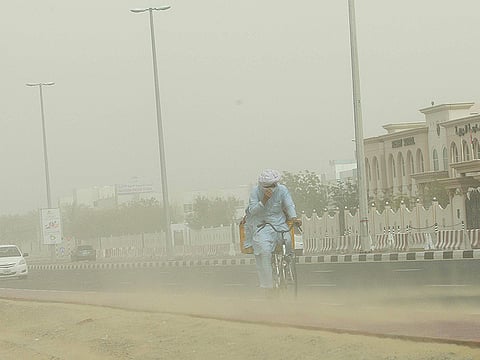UAE’s dust comes from Sahara and Rub Al Khali, researchers say
Masdar Institute unveils findings of country’s first study on dust

Abu Dhabi: Dust in the UAE comes from two deserts — the Sahara and Rub’ Al Khali, a new study by Masdar Institute of Science and Technology researchers have found.
The research, which studies where the UAE’s dust is coming from and how it affects the atmosphere, is the country’s first comprehensive dust climatology study that provides information for developing smarter climate models needed to support sustainable development, it was announced on Tuesday.
Post-doctoral researchers Dr Shaik Ghouse Basha and Dr Phani Kumar Devulapalli of Masdar Institute’s Water and Environmental Science Programme, along with Dr Taha B.M.J. Ouarda, Professor of Water and Environmental Engineering and Head of the Institute Centre for Water and Environment (iWater), are leading the dust climatology study to find critical answers to the dust storms.
The research so far tracked the origins of the dust to two deserts — the Sahara and Rub Al Khali or Empty Quarter, the world’s largest sand desert encompassing most of the southern third of the Arabian Peninsula.
“We used a combination of data collected from ground-based weather stations over the past 33 years and climate model data sets to determine various dynamics associated with dust storms and the storms’ effect on surface parameters, like precipitation, temperature, aerosol and optical properties. From surface observations, we learned when these dust storm hit and, using modelling data sets, we were able to pinpoint where the dust came from,” said Dr Basha.
They found that on average, dust storms reduce the UAE’s surface temperatures by 4.5 degrees Celsius. The dust storms begin in December, occur with the most frequency between February and March, and start decreasing until August. The average dust storm lasts 21 hours and occurs more frequently over Abu Dhabi.
Dr Basha said another interesting feature is that dust events (when visibility is from 1-5 km) over the UAE region show a significant decreasing trend whereas dust storms (when visibility is only up to 1km) show moderate increases over this region, said Dr Basha.
During a dust storm, there are huge increases in aerosols — tiny particles of soot and organic matter emitted by power plants, factories and volcanoes, as well as mineral dust wafted off from the Sahara and other large deserts.
Dr. Basha and Dr. Devulapalli are working to determine which type of aerosols are present during the storms and their chemical compositions.
While the direct economic impact of dust storms may seem minimal compared to other major weather events, long-term consequences of dust storms may take a heavy health, agricultural and energy toll on the people who live in dust-affected areas.
During dust storms, the poor air quality causes breathing difficulties, creating spikes in respiratory diseases and hospital visits.
The dust can also impact the solar energy sector. Dust accumulates on solar photovoltaic panels, making them less effective, while suspended dust in the air also reduces the amount of sunlight that reaches the ground for solar energy capture technologies.
Going forward, the researchers will investigate how dust from different regions contributes to the UAE’s dust as well as the types of weather conditions that could trigger more severe dust storms.
Sign up for the Daily Briefing
Get the latest news and updates straight to your inbox



